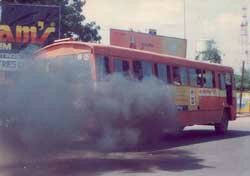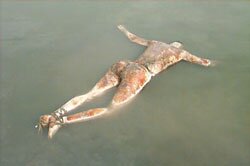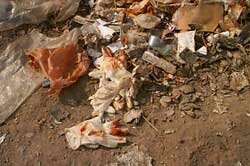|
If the recent survey of Central Pollution Control Board (CPCB) is any indication, Kanpur is sitting on an environmental time bomb which is ticking away and can explode any time. The CPCB data for January to April 2002 shows that Kanpur had the highest count of respirable suspended particulate matter (RSPM) in the country. RSPM gets into lungs and triggers respiratory ailments The RSPM levels varied from 119 to 257 micrograms per cubic metre as against the National Ambient Air Quality Standard (NAAQS) of 60 micrograms per cubic metre. On December 4, 2002, the RSPM reached 394 while on December 9, 2002 it was 320 micrograms per cubic metre. Dust concentration, diesel-driven tempos and dearth of unleaded petrol stations are the factors that contribute to the deteriorating air quality in the city.
 At present, 30,000 vehicles are added every year to the already existing 3.5 lakh traffic fleet in Kanpur. The burgeoning traffic has increased the levels of carbon monoxide, hydrocarbons, benzene, nitrogen oxides, sulphur dioxide and lead in the air. Little wonder, the dust-ridden city which had been dubbed earlier as the ‘Capital of TB’ where even monkeys have been reported to be afflicted with the deadly disease is fast turning into a hotspot for asthma. Says Dr SK Katiyar, the head of TB department in Medical College Kanpur, “In any city the asthma patients are between two to five per cent of the total population. However, in Kanpur, the number of asthma patients exceeds 10 per cent of the total population.” Experts predict that every fourth person in the city will be a victim of asthma if the air quality of Kanpur keeps plummeting at the current rate. And there are also apprehensions that it could reach epidemic proportions very soon. Interestingly, a World Bank Study in 1995 had estimated the annual environmental health cost for every citizen in Kanpur owing to ambient air pollution at US$ 50. Thus the total annual environmental health cost due to air pollution for Kanpur is approximately Rs 600 crore. At present, 30,000 vehicles are added every year to the already existing 3.5 lakh traffic fleet in Kanpur. The burgeoning traffic has increased the levels of carbon monoxide, hydrocarbons, benzene, nitrogen oxides, sulphur dioxide and lead in the air. Little wonder, the dust-ridden city which had been dubbed earlier as the ‘Capital of TB’ where even monkeys have been reported to be afflicted with the deadly disease is fast turning into a hotspot for asthma. Says Dr SK Katiyar, the head of TB department in Medical College Kanpur, “In any city the asthma patients are between two to five per cent of the total population. However, in Kanpur, the number of asthma patients exceeds 10 per cent of the total population.” Experts predict that every fourth person in the city will be a victim of asthma if the air quality of Kanpur keeps plummeting at the current rate. And there are also apprehensions that it could reach epidemic proportions very soon. Interestingly, a World Bank Study in 1995 had estimated the annual environmental health cost for every citizen in Kanpur owing to ambient air pollution at US$ 50. Thus the total annual environmental health cost due to air pollution for Kanpur is approximately Rs 600 crore.
 Next to air, the second most vital component of our life support system, i,e, water has also got chemicalised and has been severely poisoned. The main source of drinking water for the city is river Ganga, the lower Ganga canal and the ground water. Out of the total demand of 600 million litres per day (mld) approximately, river Ganga provides 200 mld of water while the canal provides 45 mld to the people of Kanpur. However, both these sources are extremely contaminated with the city sewage, industrial effluents and other non-point sources of pollution like dumping of dead bodies and defecation. Next to air, the second most vital component of our life support system, i,e, water has also got chemicalised and has been severely poisoned. The main source of drinking water for the city is river Ganga, the lower Ganga canal and the ground water. Out of the total demand of 600 million litres per day (mld) approximately, river Ganga provides 200 mld of water while the canal provides 45 mld to the people of Kanpur. However, both these sources are extremely contaminated with the city sewage, industrial effluents and other non-point sources of pollution like dumping of dead bodies and defecation.
Not only the surface water, the groundwater is also laced with hazardous chemicals. A recent report of Central Ground Water Board found the underground water in areas such as Baburia, Rakhimandi, Nauriyya Khera, Fazalganj, Juhi and Jajmau unfit for consumption . The chromium level in the groundwater of these places was between 0.132 and 10 miligram per litre which is far beyond the permissible level of 0.05 miligram per litre. Thanks to the Duncans Fertliser factory, the ground water of Panki industrial area has been found to be contaminated with alarming levels of ammonia.
A study conducted by a local NGO Eco Friends with the help of Indian Institute of Technology (IIT), Kanpur have also revealed the presence of high levels of Arsenic, Cadmium, Mercury, Dieldrin and Chrome VI in Jajmau ground water. Most of these chemicals are known carcinogens, neurological toxicants and cause a host of fatal diseases. The biggest culprits for poisoning the only drinking water source for Jajmau area in Kanpur are the 350 odd leather industries.
Not just the highly chemicalised air and contaminated water, the rotting heaps of refuse all over the city pose a deadly threat to the health of the Kanpurites. The 30 lakh population of the city generates 1,800 tonnes of waste every day. However, the Kanpur Nagar Nigam (KNN) is able to collect only half of this entire waste. Even the collected garbage is thrown at the 18 dumping sites in an extremely haphazard manner.
 In addition, even though the Supreme Court (SC) has set December 31, 2002 as a deadline for the installation of hospital waste management system, the city hospitals are downplaying the apex court’s order. Findings of CPCB indicate that there are 407 odd hospitals and nursing homes (43 government and semi-government hospitals, 360 private nursing homes and 4 defense hospitals). The combined bed capacity of these is 11,140 and the bio-medical waste generated is 3,550 kilograms per day. Paradoxically, there is no proper disposal of this highly hazardous waste which is not segregated and is thrown in the dumpyards along with the domestic waste. Only 50 odd nursing homes have adopted some bio-medical waste disposal system by sending their waste to a common incinerator. Flouting all norms, reputed hospitals such as Lala Lajpat Rai (LLR) hospital burn their medical waste with ordinary garbage in their premises. What is most shocking is the fact that the Murarilal Chest Clinic which deals primarily with tuberculosis (TB) patients drains down its hospital waste at the Bhaironghat which mixes with the Ganga water, the main raw water source for the city. Besides this, there are approximately 6,000 small, medium and large scale industries in Kanpur. Around 1,35,000 metric tones of hazardous industrial waste generated annually, which needs to be safely and scientifically disposed off, is left out in the open to damage the ecology and seep into the ground aquifers. In addition, even though the Supreme Court (SC) has set December 31, 2002 as a deadline for the installation of hospital waste management system, the city hospitals are downplaying the apex court’s order. Findings of CPCB indicate that there are 407 odd hospitals and nursing homes (43 government and semi-government hospitals, 360 private nursing homes and 4 defense hospitals). The combined bed capacity of these is 11,140 and the bio-medical waste generated is 3,550 kilograms per day. Paradoxically, there is no proper disposal of this highly hazardous waste which is not segregated and is thrown in the dumpyards along with the domestic waste. Only 50 odd nursing homes have adopted some bio-medical waste disposal system by sending their waste to a common incinerator. Flouting all norms, reputed hospitals such as Lala Lajpat Rai (LLR) hospital burn their medical waste with ordinary garbage in their premises. What is most shocking is the fact that the Murarilal Chest Clinic which deals primarily with tuberculosis (TB) patients drains down its hospital waste at the Bhaironghat which mixes with the Ganga water, the main raw water source for the city. Besides this, there are approximately 6,000 small, medium and large scale industries in Kanpur. Around 1,35,000 metric tones of hazardous industrial waste generated annually, which needs to be safely and scientifically disposed off, is left out in the open to damage the ecology and seep into the ground aquifers.
|
